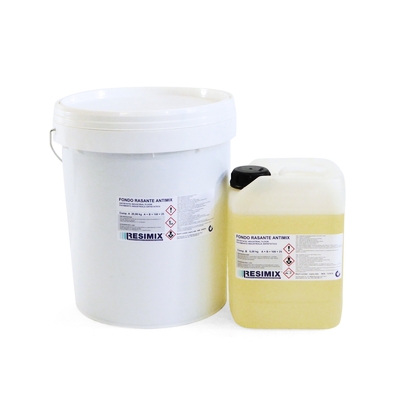FONDO RASANTE ANTIMIX
ANTISTATIC SELF-LEVELLING EPOXY SYSTEM FOR FLOOR SMOOTHIN
Self-levelling, anti-static epoxy formulation – solvent-free, surface electrical resistance of approx. 10Ohm, prepared with conductive and dissipative admixtures. USE: antistatic flooring, approx 2 mm thick.
Compared to other systems, FONDO RASANTE ANTIMIX combined with its FILLER ANTIMIX has a lower
electrical resistivity fit to discharge possible electrostatic storages.
Its use is often combined with electro conductive strips linked to the ground cable.
Application is always completed with FILLER ANTIMIX sprinkle which serves three purposes: enhance the
electrical conductivity, achieve a surface with an ideal and uniform grip and confer high resistance to wear
and tear to the epoxy coating which will form the floor finishing.
- FONDO RASANTE ANTIMIX makes it possible to incorporate a fibreglass mesh which greatly improves the floor resilience;
- It ensures excellent adhesion to concrete, stone, bricks, metal and wood;
- It hardens with no shrinkage;
- Its mechanical features do not alter in time.
| U.M | ||||||||||||||
|---|---|---|---|---|---|---|---|---|---|---|---|---|---|---|
| Compression strength (DIN 53454) | > 75 | N/mm2 | ||||||||||||
| Traction elasticity modulus (DIN 604) | 3000 | N/mm2 | ||||||||||||
| Ultimate elongation | 2,4 | % | ||||||||||||
| Resistance to tear on dry concrete (*) (ISO 4624) | > 4,5 | N/mm2 | ||||||||||||
| Resistance to tear on damp concrete (*) (ISO 4624) | > 2 | N/mm2 | ||||||||||||
| Surface electrical resistivity | 106 | Ω | ||||||||||||
| Viscosity | 2500 cP | |||||||||||||
| Specific weight at 25 °C | 1,36 | Kg/dm3 | ||||||||||||
| A + B mixture ratio | 100 + 23 |
Values achieved after 7 day hardening at 25 °C
(*) adhesion values depend on the type of concrete. Cohesive break of substrate always takes place.
Preparation of the support
The surface to be treated must be clean, healthy, dry and crumbly part and cement grout-free: best adhesion is achieved by roughening it through smoothing with diamond wheels (00 grain) or buffing.
Carefully remove any trace of dust and dirt using an aspirator.
Application on metals requires careful preparation of the support: remove oils, fats, painting and rust through abrading or white metal sand-blasting (SA 2 – SA 3 degree).
Preparation of the product
Pour component B into component A and blend at slow speed for 3’ – 5’ using mechanical stirrer to reduce air inlet as much as possible; during this operation, carefully scrape also the sides and corners of the bucket.
Application
Apply with palette knife with an average consumption of 1 – 1.5 kg/m² per layer and sprinkle the FILLER ANTIMIX.
To do reinforced smoothing, lay a fiberglass mesh on the surface: place the sheets one close to another without overlapping. Then cast the product on the mesh and spread it with a palette knife.
Notes
Packages are pre-weighed: completely use component A and component B. If you wish to divide the
package, products must be weighed observing the A+B ratio shown on the label and must not be dosed in volume.
In case of partial use of the package, do not introduce the mixer in component A and then in component B. Three essential rules are valid for all bi-component systems: weigh well, carefully mix bottom and walls, observe times of use.
Application with temperatures lower than +10 °C and higher than +40 °C is not recommended.
| temperature | use (pot-life) | hardening | ||||||||||||
|---|---|---|---|---|---|---|---|---|---|---|---|---|---|---|
| 10 °C | 90 min | 12 h | ||||||||||||
| 20 °C | 40 min | 7 h | ||||||||||||
| 30 °C | 25 min | 5 h | ||||||||||||
| 40 °C | 18 min | 3 h |
Full hardening after 7 days.
In case of simple smoothing, consumption is of 1 – 1.2 kg/m2 with 3 kg quartz sprinkle, usually 0.3 – 0.9.
To achieve reinforced smoothing with fibreglass mesh the product is applied in two layers: in the first one
consumption is of 1.5 kg/m2 with 3.5 – 4 kg quartz sprinkle; in the second case you need 1 – 1.2 kg/m2 of product with 3 kg/m2 quartz sprinkle.
Available in 12,3 kg packages (A + B component).
Packages must be kept vertically and sealed: the product remains unaltered for at least a year if kept in a dry and sheltered place at a temperature between 10 and 30 °C.
1 – 2 mm low and medium thickness smoothing of horizontal surfaces to create layers of selflevelling
and multi-layered antistatic floors like ANTIMIX (Hospitals, surgery room, electronic industry and whenever is necessary to avoid electrostatic storage.

